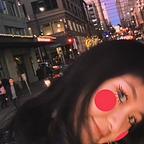HCDE 451 A3: 2.5D Phone Stand Cardboard Prototype
In this week’s studio, we learned basic laser cutting techniques such as setting the pen strokes for engraving texts through a demo demonstrated by the Fluke Makerpace’s staff. Through this demo, I learned the basic functions of Rhino (but I still used Illustrator to draw the vector file).
Design for This Week
The design for this week is to design and build a prototyping tool using cardboard and a laser cutter. I decided to make a cell phone stand for shooting video of an object below it since I always get annoyed by finding the best shooting angle or lighting position to take photos of my design.
The specifications for the phone stand are as follows:
- must be cut from a single sheet of 18" x 24" chipboard
- must not use any glue, tape, or other fastening materials to assemble and use
- must be able to be dissembled into pieces that can be stored flat and transported
Idea Sketching
Because there are already too many designs of the phone stand existed on the markets, to be honest, I had no single design idea in my mind because I could immediately recall three different designs I have seen when I shopped on Amazon. It was hard to think outside of the box and create something very different from most of the design. I was stuck.
However, I just suddenly got inspired by seeing people using the scanner in the Allen Library. Here is a photo of the scanner from different perspectives. I was especially inspired by the wave curve and the base and decided to adopt this structure for my phone stand.
I like this structure because, to design a phone stand for video shooting, it must meet this design criterion — be able to place the phone at a certain height so that the full view below can be covered.
With this structure, I had the base, the support sides and now I just need to figure out where to place the phone itself. I did some research online and finalized the idea by adding another small piece of cardboard on the top (inserting the upper board into the slots cut on the curved support bars)as the place to put on the phone. So basically, my phone stand has three main parts:
- a top platform
- the curved support bars
- a base platform
Prototype
As someone who doesn’t have many experiences in building a 3D object, I printed out the first version as a tryout and to see where I need to make adjustments. I didn’t expect the first version would stand steady. Without a doubt, my first one was failed because of the following reasons:
- The stand couldn’t stand steady and easily bent because the single wall cardboard was too flimsy to support the weight of any phones
- The width and depth of the slots were measured incorrectly and were too big to build a strong connection
The first version was so fragile that it couldn’t even support the weight of a fake paper phone :(
For the next version, I switched my material (with professor’s permission)from the single wall cardboard to the double-wall one, which was way more rigid than the previously used one. Learning from the previous mistakes, I made several improvements:
- Decreased the width and depth of the slots to ensure each knot can joint tightly
- Increased the support bars from 3 to 5 to provide more support
- Made other two top boards accommodate different brands of phone (camera is placed in different locations based on the brands)
Testing Analysis
I displayed this stand during studio time and received some positive feedback from classmates.
What needed improvements:
- the structure of the prototype in order to increase the strength of the stand
- the size of the top board
Even though I changed the material to the double-wall cardboard, the stand was still wobbly when a bigger or heavier phone (iPhone 6s was used in the above picture) was placed on top of it. If I want to hold heavier and bigger devices like the iPhone 8plus, I need to reconstruct the current structure. One of my favorite suggestions I received was to add more bars on both left and right sides (forming a semi-circle shape) to make it more stable and aesthetic.
What worked well:
- the sleek, curved design of the support bars
- the engraved letter on the base
- the angle of filming
Conclusion
The practical concept of a phone stand is favorable. The stand I made was out for pragmatic purpose without considering aesthetic aspects, yet still, had received positive feedback from users. I believe that the compliment “elegant design!” was for the simple design and intuitive affordance of the stand. This project helps me realize the importance of the practical value of an object.
